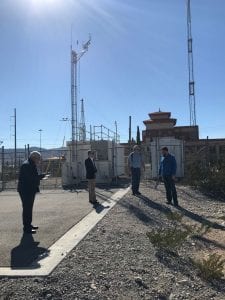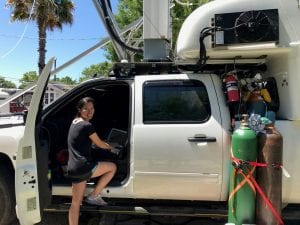- TRACER-MAP: The project is focused on Mapping Aerosol Processes across Houston during convective cell events. We conducted measurements in Houston in the summer of 2022 to tie into an overarching, multi-institution, multi-agency research project called Tracking Aerosol Convection Interactions Experiment (TRACER). The project is a collaboration of the Sheesley group with Sascha Usenko (Baylor), Rob Griffin (Rice University), James Flynn (UH), Yuxuan Wang (UH), and Don Collins (UCR) is funded by the Department of Energy Atmospheric Science Research program (DOE ASR). TRACER-MAP collaborated with DOE, NASA and TCEQ on this project.


https://www.arm.gov/news/features/post/88794
https://www.arm.gov/research/campaigns/amf2021tracer-map
https://www-air.larc.nasa.gov/missions/tracer-aq/index.html
- Arctic carbon
New NSF-funded project, BEAR-oNS (biogenic emissions and aerosol response on the North Slope). This project is in collaboration with Alex Guenther (UCI), Claudia Czimczik (UCI) and Kelley Barsanti (UCR).
Recent NOAA and DOE-funded campaigns on the North Slope of Alaska were at two locations: Utqiaġvik (formerly Barrow) and Oliktok Point. We collected PM1.0 and TSP samples at the DOE ARM sites at each location. Using these samples we will determine organic, elemental and water-soluble carbon, in addition to inorganic ions, organic molecular markers and radiocarbon. Using these measurements we will be able to determine sources of atmospheric aerosols and spatial heterogeneity of these sources in the North  American Arctic.
American Arctic.
Toolik and Utqiagvik, AK: VOC and aerosol measurements were completed in summers of 2022 and are on-going in 2023.
Oliktok and Barrow, AK: For summer 2015 and June 2016 to September 2017, we collected particulate matter samples at DOE ARM sites in Utqiaġvik and Oliktok, AK.
Utqiaġvik, AK: From July 2012 to Jun 2013 we collected PM2.5 and PM10 particulate matter samples at the DOE site in Utqiaġvik, AK.
Recent press:
https://phys.org/news/2019-02-term-sources-black-carbon-arctic.html
https://ensia.com/features/black-carbon/
- Regional air quality studies
We work closely with the Usenko research group https://www.baylor.edu/usenko/ and the Flynn research group at University of Houston for regional air quality studies.
- Corpus Christi and San Antonio (2020-21): We are working with Rob Griffin (Rice University), James Flynn (UH), and Yuxuan Wang (UH) to study sources, transport and atmospheric chemistry in Corpus Christi and San Antonio during ozone season. This research is funded by the Texas Air Quality Research Program.
 (BC)2 in Houston and El Paso, TX (2019-23): We are working with the University of Houston to study black and brown carbon trends and sources. This research has received funding from both the Texas Commission on Environmental Qualityis and the Texas Air Quality Research Program. The future site is shown below on the University of Texas at El Paso campus.
(BC)2 in Houston and El Paso, TX (2019-23): We are working with the University of Houston to study black and brown carbon trends and sources. This research has received funding from both the Texas Commission on Environmental Qualityis and the Texas Air Quality Research Program. The future site is shown below on the University of Texas at El Paso campus.
3. San Antonio, TX: We are working with University of Houston and Rice University to study ozone production and air quality in San Antonio, TX in May 2017. This research is funded by the Texas Commission on Environmental Quality.
4. Houston, TX/DISCOVER-AQ: The focus of this project was an intensive field campaign in Sep 2013 during the NASA DISCOVER-AQ campaign in Houston. Our surface-based sampling coincided in time and location with NASA flights over Houston which monitored gaseous and particulate air pollution vertical profiles The Sheesley and Usenko Labs conducted realtime and filter collection at the surface for characterization of organic and elemental carbon, stable and radiogenic isotopes and organic tracers.
5. Fort Worth, TX: The Sheesley and Usenko Labs participated in the June 2011 multi-institution field campaign at Eagle Mountain Lake, north of Fort Worth. We collected filter samples of PM2.5 to monitor organic and elemental carbon and organic tracers for source apportionment.
6. Riesel, TX air monitoring site: This site has been in operation since the Summer of 2011 with the encouragement of Daren Harmel of the USDA at their research farm near Riesel, TX and the support of the Baylor Environmental Science Department. We have set up a semi-permanent air monitoring site which will function as a regional monitoring station for PM2.5.







